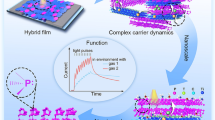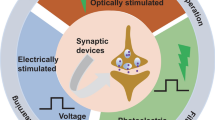Abstract
Both electric and chemical synapses play an important role in receiving and propagating signals, and thus an isolated neuron and neurons in networks can be activated to trigger appropriate firing modes. The synaptic plasticity enables adaptive regulation in the channel current along the synapse connection, and the intrinsic field energy in the media is pumped to keep possible balance between neurons. The Hamilton energy function in biophysical neurons addressed its dependence of energy on firing modes, and the same energy in neurons seldom indicates complete synchronization because the energy function is often composed of more than two variables in the neuron models. In this paper, we claim that the creation and waking up of synapses connection result from the diversity in field energy of neurons. From physical viewpoint, each neuron can be considered as a complex charged body and any external stimulus will change the distribution of field energy. For two and more neurons, the external stimulus-induced fluctuation in field energy will activate the synapses of neurons, and more synaptic connections will be enhanced for keeping energy balance. That is, the coupling intensity via synapse connection to neurons will be regulated in a possible way. In this work, two simple neural circuits are mapped into feasible neuron models for investigating the energy pumping and propagation by adjusting the intensity along the coupling channel until energy balance is approached. Furthermore, a similar case is explored in a chain network, and it is found that continuous energy pumping to the adjacent neurons will build up a network connected by synapses. These results clarify that synapses connection is activated between neurons because of gradient diversity in field energy in neurons and networks, and then synapse connections are waken up effectively when field energy is propagated to and received by adjacent neurons. That is, synapse connections are formed and waken when gradient field energy is shared by more neurons. The main contribution of this work is that a reliable criterion is suggested to explain how energy diversity controls the creation of synapse and the enhancement of synapse connection to neurons. That is, the biophysical mechanism of synaptic connection is controlled by the energy diversity between neurons, and the synapse coupling will terminate its increase in the coupling intensity until reaching energy balance between neurons even in neural network.












Similar content being viewed by others
Data availability
All data generated or analyzed during this study are included in this article.
References
Gerstner, W., Naud, R.: How good are neuron models? Science 326(5951), 379–380 (2009)
Shilnikov, A.: Complete dynamical analysis of a neuron model. Nonlinear Dyn. 68, 305–328 (2012)
Gomar, S., Ahmadi, A.: Digital multiplierless implementation of biological adaptive-exponential neuron model. IEEE Trans. Circuits Syst. I Regul. Pap. 61, 1206–1219 (2013)
Kasabov, N.: To spike or not to spike: A probabilistic spiking neuron model. Neural Netw. 23, 16–19 (2010)
Lin, H.R., Wang, C., Sun, Y., et al.: Firing multistability in a locally active memristive neuron model. Nonlinear Dyn. 100, 3667–3683 (2020)
Longtin, A.: Stochastic resonance in neuron models. J. Stat. Phys. 70, 309–327 (1993)
Harmer, G.P., Davis, B.R., Abbott, D.: A review of stochastic resonance: Circuits and measurement. IEEE Trans. Instrum. Meas. 51, 299–309 (2002)
McDonnell, M.D., Abbott, D.: What is stochastic resonance? Definitions, misconceptions, debates, and its relevance to biology. PLoS Comput. Biol. 5, e1000348 (2009)
Karak, S., Jacobs, J.S., Kittelmann, M., et al.: Diverse roles of axonemal dyneins in Drosophila auditory neuron function and mechanical amplification in hearing. Sci. Rep. 5, 17085 (2015)
Wang, M., Liao, X., Li, R., et al.: Single-neuron representation of learned complex sounds in the auditory cortex. Nat. Commun. 11, 4361 (2020)
Guo, Y., Zhou, P., Yao, Z., et al.: Biophysical mechanism of signal encoding in an auditory neuron. Nonlinear Dyn. 105, 3603–3614 (2021)
Mizrahi, A., Shalev, A., Nelken, I.: Single neuron and population coding of natural sounds in auditory cortex. Curr. Opin. Neurobiol. 24, 103–110 (2014)
Wiederman, S.D., O’Carroll, D.C.: Selective attention in an insect visual neuron. Curr. Biol. 23, 156–161 (2013)
Gabbiani, F., Krapp, H.G., Hatsopoulos, N., et al.: Multiplication and stimulus invariance in a looming-sensitive neuron. J. Physiol.-Paris 98(1–3), 19–34 (2004)
Guest, B.B., Gray, J.R.: Responses of a looming-sensitive neuron to compound and paired object approaches. J. Neurophysiol. 95, 1428–1441 (2006)
Gabbiani, F., Krapp, H.G.: Spike-frequency adaptation and intrinsic properties of an identified, looming-sensitive neuron. J. Neurophysiol. 96, 2951–2962 (2006)
Chowdhury, S., Jarecki, B.W., Chanda, B.: A molecular framework for temperature-dependent gating of ion channels. Cell 158, 1148–1158 (2014)
O’Leary, T., Marder, E.: Temperature-robust neural function from activity-dependent ion channel regulation. Curr. Biol. 26(21), 2935–2941 (2016)
Xing, M., Song, X., Yang, Z., et al.: Bifurcations and excitability in the temperature-sensitive Morris-Lecar neuron. Nonlinear Dyn. 100, 2687–2698 (2020)
Finke, C., Freund, J.A., Rosa, E., Jr., et al.: Temperature-dependent stochastic dynamics of the Huber-Braun neuron model. Chaos 21, 047510 (2011)
Zhou, P., Yao, Z., Ma, J., et al.: A piezoelectric sensing neuron and resonance synchronization between auditory neurons under stimulus. Chaos Solitons Fractals 145, 110751 (2021)
Zhang, X.F., Ma, J.: Wave filtering and firing modes in a light-sensitive neural circuit. J. Zhejiang Univ.-Sci. A 22, 707–720 (2021)
Liu, Y., Xu, W., Ma, J., et al.: A new photosensitive neuron model and its dynamics. Front. Inf. Technol. Electron. Eng. 21, 1387–1396 (2020)
Xie, Y., Zhu, Z.G., Zhang, X.F., et al.: Control of firing mode in nonlinear neuron circuit driven by photocurrent. Acta Phys. Sin. 70(21), 210502 (2021)
Xie, Y., Yao, Z., Hu, X., et al.: Enhance sensitivity to illumination and synchronization in light-dependent neurons. Chin Phys. B 30, 120510 (2021)
Xu, Y., Liu, M., Zhu, Z., et al.: Dynamics and coherence resonance in a thermosensitive neuron driven by photocurrent. Chin. Phys. B 29, 098704 (2020)
Lien, J.P., Fang, T., Buckner, G.D.: Hysteretic neural network modeling of spring-coupled piezoelectric actuators. Smart Mater. Struct. 20(6), 065007 (2011)
Chen, Y., Qiu, J., Sun, H.: A hybrid model of Prandtl-Ishlinskii operator and neural network for hysteresis compensation in piezoelectric actuators. Int. J. Appl. Electromagnet Mech 41(3), 335–347 (2013)
Sheu, G.J., Yang, S.M., Huang, W.L.: Simulating displacement and velocity signals by piezoelectric sensor in vibration control applications. Smart Mater. Res. 2012, 390873 (2012)
Sun, T., Wright, J., Datta-Chaudhuri, T.: Ultrasound powered piezoelectric neurostimulation devices: a commentary. Bioelectron. Med. 6, 16 (2020)
Navaraj, W., Dahiya, R.: Fingerprint-enhanced capacitive-piezoelectric flexible sensing skin to discriminate static and dynamic tactile stimuli. Adv. Intell. Syst. 1, 1900051 (2019)
Yao, Z., Zhou, P., Zhu, Z., et al.: Phase synchronization between a light-dependent neuron and a thermosensitive neuron. Neurocomputing 423, 518–534 (2021)
Bandyopadhyay, S., Das, A., Mukherjee, A., et al.: A linearization scheme for thermistor-based sensing in biomedical studies. IEEE Sens. J. 16, 603–609 (2015)
Keskin, A.Ü., Yanar, T.M.: Steady-state solution of loaded thermistor problems using an electrical equivalent circuit model. Meas. Sci. Technol. 15(10), 2163 (2004)
Uwate, Y., Nishio, Y.: Synchronization phenomena in van der Pol oscillators coupled by a time-varying resistor. Int. J. Bifurc. Chaos 17, 3565–3569 (2007)
Volos, C.K., Kyprianidis, I.M., Stouboulos, I.N., et al.: Memristor: a new concept in synchronization of coupled neuromorphic circuits. J. Eng. Sci. Technol. Rev. 8, 157–173 (2015)
Gambuzza, L.V., Buscarino, A., Fortuna, L., et al.: Memristor-based adaptive coupling for consensus and synchronization. IEEE Trans. Circuits Syst. I Regul. Pap. 62, 1175–1184 (2015)
Chen, C., Chen, J., Bao, H., et al.: Coexisting multi-stable patterns in memristor synapse-coupled Hopfield neural network with two neurons. Nonlinear Dyn. 95, 3385–3399 (2019)
Li, Z., Zhou, H., Wang, M., et al.: Coexisting firing patterns and phase synchronization in locally active memristor coupled neurons with HR and FN models. Nonlinear Dyn. 104, 1455–1473 (2021)
Bao, B., Yang, Q., Zhu, D., et al.: Initial-induced coexisting and synchronous firing activities in memristor synapse-coupled Morris-Lecar bi-neuron network. Nonlinear Dyn. 99, 2339–2354 (2020)
Ostojic, S.: Two types of asynchronous activity in networks of excitatory and inhibitory spiking neurons. Nat. Neurosci. 17(4), 594–600 (2014)
Brunel, N.: Dynamics of sparsely connected networks of excitatory and inhibitory spiking neurons. J. Comput. Neurosci. 8, 183–208 (2000)
Ma, J., Yang, Z., Yang, L., et al.: A physical view of computational neurodynamics. J. Zhejiang Univ.-Sci. A 20, 639–659 (2019)
Kyprianidis, I.M., Papachristou, V., Stouboulos, I.N., et al.: Dynamics of coupled chaotic Bonhoeffer-van der Pol Oscillators. WSEAS Trans. Syst. 11, 516–526 (2012)
Zhang, Y., Wang, C.N., Tang, J., et al.: Phase coupling synchronization of FHN neurons connected by a Josephson junction. Sci. China Technol. Sci. 63, 2328–2338 (2020)
Reinel, D., Dieterich, W., Wolf, T., et al.: Flux-flow phenomena and current-voltage characteristics of Josephson-junction arrays with inductances. Phys. Rev. B 49(13), 9118 (1994)
Zhang, Y., Xu, Y., Yao, Z., et al.: A feasible neuron for estimating the magnetic field effect. Nonlinear Dyn. 102, 1849–1867 (2020)
Zhang, Y., Zhou, P., Tang, J., et al.: Mode selection in a neuron driven by Josephson junction current in presence of magnetic field. Chin. J. Phys. 71, 72–84 (2021)
Wang, C., Tang, J., Ma, J.: Minireview on signal exchange between nonlinear circuits and neurons via field coupling. Eur. Phys. J. Spec. Top. 228(10), 1907–1924 (2019)
Zhou, P., Hu, X., Zhu, Z., et al.: What is the most suitable Lyapunov function? Chaos Solitons Fractals 150, 111154 (2021)
Gonze, D., Bernard, S., Waltermann, C., et al.: Spontaneous synchronization of coupled circadian oscillators. Biophys. J . 89, 120–129 (2005)
Wang, C., Guo, S., Xu, Y., et al.: Formation of autapse connected to neuron and its biological function. Complexity 2017, 5436737 (2017)
Ma, J., Song, X., Tang, J., et al.: Wave emitting and propagation induced by autapse in a forward feedback neuronal network. Neurocomputing 167, 378–389 (2015)
Yao, C., He, Z., Nakano, T., et al.: Inhibitory-autapse-enhanced signal transmission in neural networks. Nonlinear Dyn. 97, 1425–1437 (2019)
Yilmaz, E., Ozer, M., Baysal, V., et al.: Autapse-induced multiple coherence resonance in single neurons and neuronal networks. Sci. Rep. 6, 30914 (2016)
Aghababaei, S., Balaraman, S., Rajagopal, K., et al.: Effects of autapse on the chimera state in a Hindmarsh-Rose neuronal network. Chaos Solitons Fractals 153, 111498 (2021)
Qin, H.X., Ma, J., Jin, W.Y., et al.: Dynamics of electric activities in neuron and neurons of network induced by autapses. Sci. China Technol. Sci. 57, 936–946 (2014)
Protachevicz, P.R., Iarosz, K.C., Caldas, I.L., et al.: Influence of autapses on synchronisation in neural networks with chemical synapses. Front. Syst. Neurosci. 14, 91 (2020)
Yilmaz, E., Baysal, V., Ozer, M., et al.: Autaptic pacemaker mediated propagation of weak rhythmic activity across small-world neuronal networks. Physica A 444, 538–546 (2016)
Jia, Y., Gu, H., Li, Y., et al.: Inhibitory autapses enhance coherence resonance of a neuronal network. Commun. Nonlinear Sci. Numer. Simul. 95, 105643 (2021)
Acknowledgements
This project is supported by the National Natural Science Foundation of China under Grants 12062009 and 12072139.
Author information
Authors and Affiliations
Corresponding author
Ethics declarations
Conflict of interest
The authors declare that they have no conflict of interest.
Additional information
Publisher's Note
Springer Nature remains neutral with regard to jurisdictional claims in published maps and institutional affiliations.
Rights and permissions
About this article
Cite this article
Zhou, P., Zhang, X. & Ma, J. How to wake up the electric synapse coupling between neurons?. Nonlinear Dyn 108, 1681–1695 (2022). https://doi.org/10.1007/s11071-022-07282-0
Received:
Accepted:
Published:
Issue Date:
DOI: https://doi.org/10.1007/s11071-022-07282-0




